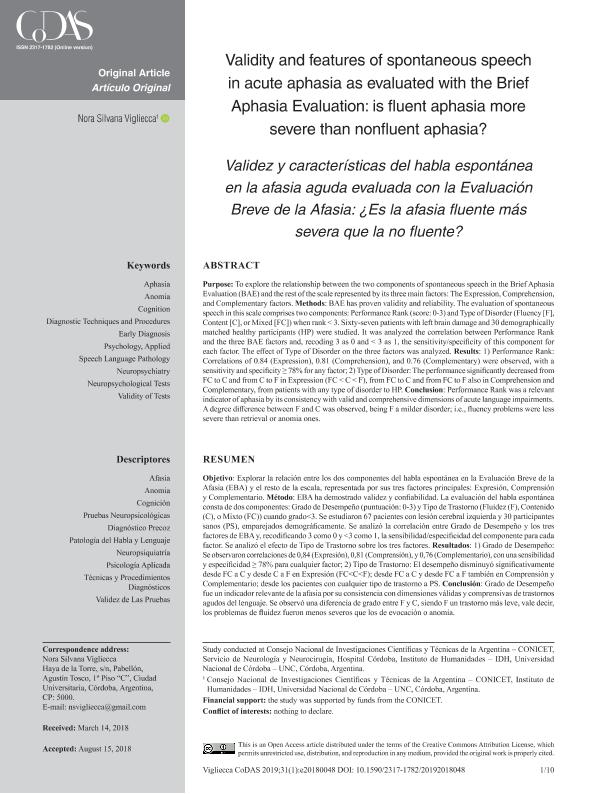Mostrar el registro sencillo del ítem
dc.contributor.author
Vigliecca, Nora Silvana

dc.date.available
2020-12-10T14:08:20Z
dc.date.issued
2019-03
dc.identifier.citation
Vigliecca, Nora Silvana; Validity and features of spontaneous speech in acute aphasia as evaluated with the Brief Aphasia Evaluation: Is fluent aphasia more severe than nonfluent aphasia?; Revista Pro-Fono; CODAS; 31; 1; 3-2019
dc.identifier.uri
http://hdl.handle.net/11336/120098
dc.description.abstract
To explore the relationship between the two components of spontaneous speech in the Brief Aphasia Evaluation (BAE) and the rest of the scale represented by its three main factors: The Expression, Comprehension, and Complementary factors. Methods: BAE has proven validity and reliability. The evaluation of spontaneous speech in this scale comprises two components: Performance Rank (score: 0-3) and Type of Disorder (Fluency [F], Content [C], or Mixed [FC]) when rank < 3. Sixty-seven patients with left brain damage and 30 demographically matched healthy participants (HP) were studied. It was analyzed the correlation between Performance Rank and the three BAE factors and, recoding 3 as 0 and < 3 as 1, the sensitivity/specificity of this component for each factor. The effect of Type of Disorder on the three factors was analyzed. Results: 1) Performance Rank: Correlations of 0.84 (Expression), 0.81 (Comprehension), and 0.76 (Complementary) were observed, with a sensitivity and specificity ≥ 78% for any factor; 2) Type of Disorder: The performance significantly decreased from FC to C and from C to F in Expression (FC < C < F), from FC to C and from FC to F also in Comprehension and Complementary, from patients with any type of disorder to HP. Conclusion: Performance Rank was a relevant indicator of aphasia by its consistency with valid and comprehensive dimensions of acute language impairments. A degree difference between F and C was observed, being F a milder disorder; i.e., fluency problems were less severe than retrieval or anomia ones.
dc.description.abstract
Explorar la relación entre los dos componentes del habla espontánea en la Evaluación Breve de la Afasia (EBA) y el resto de la escala, representada por sus tres factores principales: Expresión, Comprensión y Complementario. Método: EBA ha demostrado validez y confiabilidad. La evaluación del habla espontánea consta de dos componentes: Grado de Desempeño (puntuación: 0-3) y Tipo de Trastorno (Fluidez (F), Contenido(C), o Mixto (FC)) cuando grado < 3. Se estudiaron 67 pacientes con lesión cerebral izquierda y 30 participantes sanos (PS), emparejados demográficamente. Se analizó la correlación entre Grado de Desempeño y los tres factores de EBA y, recodificando 3 como 0 y <3 como 1, la sensibilidad/ especificidad del componente para cada factor. Se analizó el efecto de Tipo de Trastorno sobre los tres factores. Resultados: 1) Grado de Desempeño: Se observaron correlaciones de 0,84 (Expresión), 0,81 (Comprensión), y 0,76 (Complementario), con una sensibilidad y especificidad ≥ 78% para cualquier factor; 2) Tipo de Trastorno: El desempeño disminuyó significativamente desde FC a C y desde C a F en Expresión (FC < C < F); desde FC a C y desde FC a F también en Comprensión y Complementario; desde los pacientes con cualquier tipo de trastorno a PS. Conclusión: Grado de Desempeño fue un indicador relevante de la afasia por su consistencia con dimensiones válidas y comprensivas de trastornos agudos del lenguaje. Se observó una diferencia de grado entre F y C, siendo F un trastorno más leve, vale decir, los problemas de fluidez fueron menos severos que los de evocación o anomia.
dc.format
application/pdf
dc.language.iso
eng
dc.publisher
Revista Pro-Fono
dc.rights
info:eu-repo/semantics/openAccess
dc.rights.uri
https://creativecommons.org/licenses/by/2.5/ar/
dc.subject
AFASIA
dc.subject
ANOMIA
dc.subject
COGNICIÓN
dc.subject
COGNITION
dc.subject
DIAGNÓSTICO PRECOZ
dc.subject
PATOLOGÍA DEL HABLA Y LENGUAJE
dc.subject
PRUEBAS NEUROPSICOLÓGICAS
dc.subject
PSICOLOGÍA APLICADA
dc.subject
TÉCNICAS Y PROCEDIMIENTOS
dc.subject
VALIDEZ DE LAS PRUEBAS
dc.subject.classification
Otras Psicología

dc.subject.classification
Psicología

dc.subject.classification
CIENCIAS SOCIALES

dc.title
Validity and features of spontaneous speech in acute aphasia as evaluated with the Brief Aphasia Evaluation: Is fluent aphasia more severe than nonfluent aphasia?
dc.title
Validez y características del habla espontánea en la afasia aguda evaluada con la Evaluación Breve de la Afasia: ¿Es la afasia fluente más severa que la no fluente?
dc.type
info:eu-repo/semantics/article
dc.type
info:ar-repo/semantics/artículo
dc.type
info:eu-repo/semantics/publishedVersion
dc.date.updated
2020-11-19T21:14:28Z
dc.identifier.eissn
2317-1782
dc.journal.volume
31
dc.journal.number
1
dc.journal.pais
Brasil

dc.journal.ciudad
San Pablo
dc.description.fil
Fil: Vigliecca, Nora Silvana. Consejo Nacional de Investigaciones Científicas y Técnicas. Centro Científico Tecnológico Conicet - Córdoba. Instituto de Humanidades. Universidad Nacional de Córdoba. Instituto de Humanidades; Argentina
dc.journal.title
CODAS
dc.relation.alternativeid
info:eu-repo/semantics/altIdentifier/url/https://www.ncbi.nlm.nih.gov/pubmed/30843923
dc.relation.alternativeid
info:eu-repo/semantics/altIdentifier/doi/http://dx.doi.org/10.1590/2317-1782/20192018048
dc.relation.alternativeid
info:eu-repo/semantics/altIdentifier/url/https://www.scielo.br/scielo.php?script=sci_arttext&pid=S2317-17822019000100312&lng=en&nrm=iso&tlng=en
Archivos asociados
